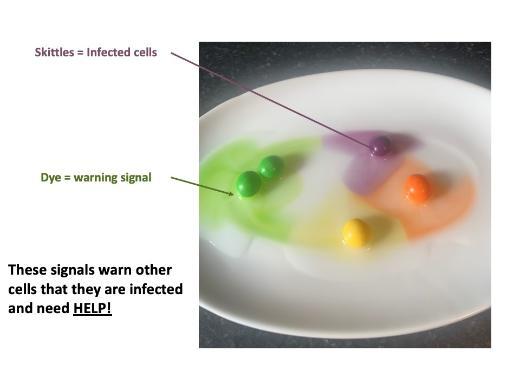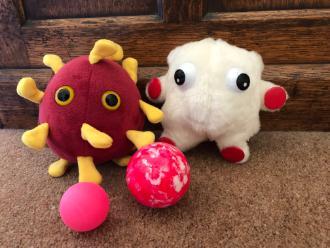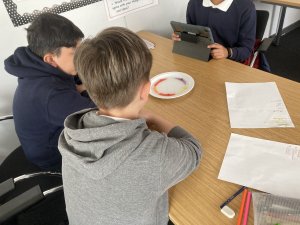Activities
2021: How do virus infected cells get the help they need?
The scientists were unable to visit the school in-person in 2021 due to the COVID19 restrictions. We also decided to run a compacted version of the project to ensure the delivery was feasible.
The theme of 2021 was communication between virus infected cells and immune cells. We delivered three one hour sessions online, tuning into the classroom via TEAMS. Each session had a short display of information via slides and most of the time was set aside for activities. You can download our slides 2021 PowerPoint Slides and learn about the activities below. These activities were to help the pupils understand the various steps involved in an immune response: infected cells calling from help; communicating between immune cells about the infection; and the triggering of a tailored response to get rid of the infection.
Following advice from the teacher in Year 1, we made a Glossary of terms for the pupils which can be viewed at the bottom of the page, or download Glossary Year 2
+++
Activity 1: Warning signals from infected cells

In this activity, we aimed for the pupils to learn how cells send out a call for help after they have been infected with a virus. We used skittles and hot water to show how signals spread out from infected cells.
You can find the How To Warning Signals Activity
---
+++
Activity 2: Spot the infected cell
In this activity, we adapted the well-known ‘wink-murder’ game to help the pupils understand that immune cells can spot infected cells.
You can find the How To Spot the Infected Cell Activity
---
+++
Activity 3: Match the immune response
![]()
![]()

In this activity, we wanted the pupils to see how the different parts of the immune response to the virus fit together. Using virus and immune cell soft toys, and balls to represent immune cells and molecules, we asked the pupils to match up the virus to the right immune response.
You can find the How To CoIMMUNicate Activity Handout
We could have improved this activity by having more distinct colours in the viruses – an overlap in colours made it difficult for the pupils to match correctly.
---
+++
Immune cell job advert
To consolidate the pupils’ learning after each activity, we asked them to complete worksheets illustrating a job advert to match a specialised immune cell with a virus. You can download a version of the poster below to use in your own activities and look through some terrifying viruses that the pupils drew.
Download powerpoint resources:
We could have improved this activity by including a clear space for the pupils to write their names and by having a separate space for warning signals and communicating cells.
---
+++
Evaluation
The engagement was a success – the pupils reported that they enjoyed the activities and learnt from them and the more formal teaching. They were engaged – as observed by their willingness to answer questions, talk about the activities with each other and describe their learning through completion of the worksheets, which we assessed to be correctly filled in by the majority of pupils.
You can read the detail of our evaluation by clicking here.
Improvements
The more detailed evaluation we performed here was informed by gaps we had identified in Year 1. The main improvement we identified in Year 2 would have been to carry out the engagement in person, although online engagement worked better than we had anticipated. In-person engagement would have been longer, we restricted each online meeting to one hour and an extended interaction would have enabled us to allow the pupils to spend more time on each of the activities. Our main learning from completing the tasks online were the importance of planning between the researchers and the teacher to ensure a smooth delivery. It also helped that we had interacted with the pupils earlier that year online to discuss the feedback for the Co-IMMUNicate App.
---
+++
Glossary
- Be prepared cells: These are immune cells that are ready waiting for an infection to happen or can move into an organ to help after an infection.
- Circulating cells: these are immune cells that move about the body waiting to be called into an organ that has an infection.
- Communicating cells: these are immune cells that take information from an area of infection to the base of the immune system to warn the immune system about an infection. In science we call these dendritic cells.
- Cytokines: these are protein messages that cells make to communicate with each other. These include warning signals released by infected cells. The name is from a Greek word ‘cyto’ meaning ‘container’ that biologists use to mean ‘cell’ and ‘kine’ from the Greek means movement – so this is a substance moving out of a cell.
- Immune cells: these are cells that protect the body from infections. There are lots of different types of immune cell that work together to protect the body.
- Immune ‘fire station’: these are organs where many immune cells are based. Here they learn about the infections and decide how to get rid of the infection. These ‘fire stations’ are called lymph nodes.
- Lung cells: these cells make up the lung giving it structure so it can function properly.
- Respiratory system: this is the part of the body that ensures you can breathe in the oxygen you need and breath out carbon dioxide. It includes the nose, throat, and lungs.
- Resident cell: these are immune cells that live in the body’s organs where they wait for an infection. They can respond quickly to protect the body from an infection.
- Snot: this is made by immune cells in the upper respiratory system (nose/mouth) and helps to capture bugs so that the body can expel them.
- Specialised immune cells: these are immune cells that can recognise a particular virus and make a special response to that particular virus.
- Virus: these are bugs that infect cells and make lots of copies of themselves. They cause damage to cells and make the body feel unwell.
- Virus transmission: this describes how viruses can move between different people – for example by an infected person coughing or sneezing on someone else.
---


